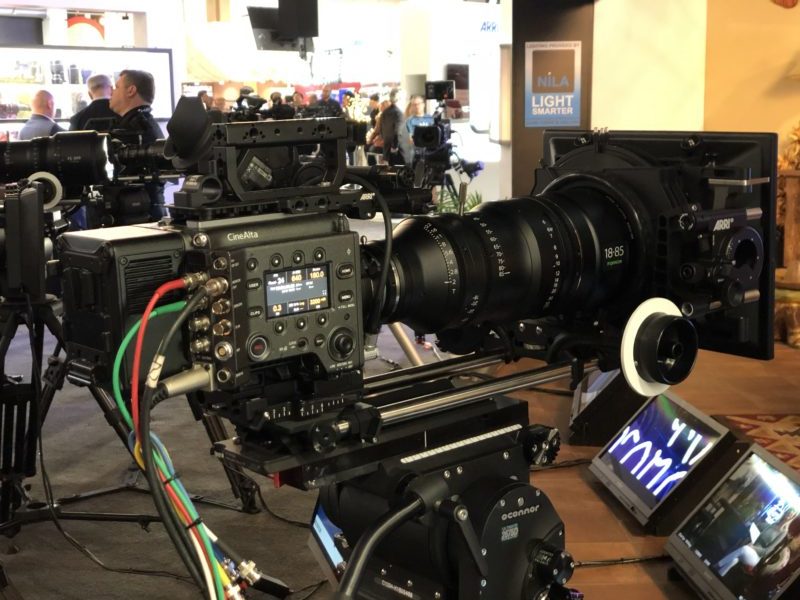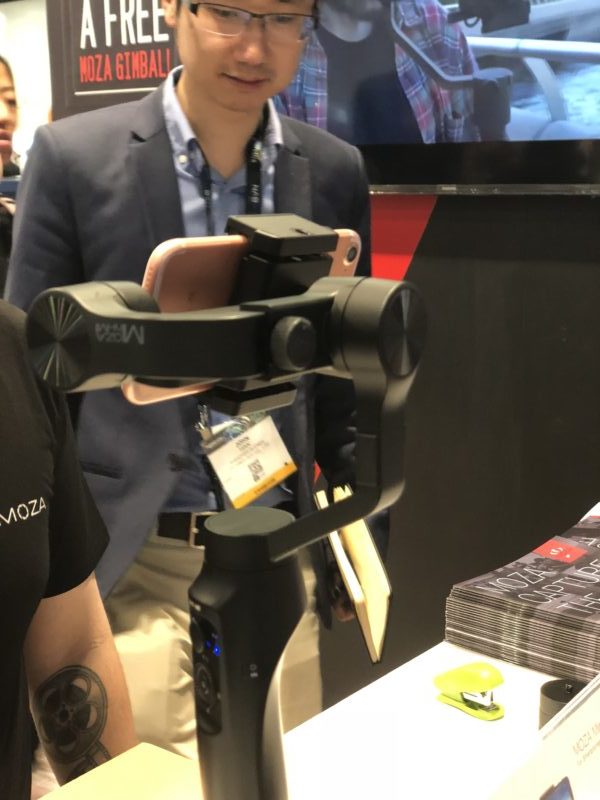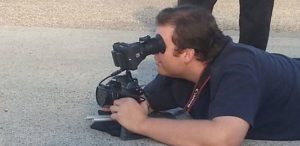Why I bought The “Expensive” Phone Stabilizer
Guest post by Thomas Meek
I finally upgraded from my iPhone 6+ to an iPhoneX back in February, primarily because my job had evolved to involve shooting a lot more social media, and behind the scenes pictures and video. The 6+ was starting to run sluggishly and the pictures weren’t looking as good as I knew they should.
Since upgrading, I’d been agonizing over a gimbal for the phone. I very quickly got tired of my own (and client’s) facebook live videos looking handheld, and the cheap rig (basically a phone clamp between two handles with a couple of cold-shoe mounts on top) just wasn’t cutting it anymore. The options I had simply didn’t live up to the look I wanted to achieve, possibly because I’ve spoiled myself on bigger projects by putting my Sony A7s on a DJI Ronin-M, but that’s another matter.
I had decided to buy one sometime this year and put it on my list of things to seriously check out when I went out to the National Association of Broadcasters (NAB) convention in Las Vegas back in April. For those of you who don’t know, the NAB convention is huge – virtually any company that develops tech or software for the broadcast or filmmaking industry has a presence there (except, notably GoPro was missing this year). So of course you’ve got the majors – Sony, Blackmagic, Canon, Panasonic, Fujifilm, etc. and their booths are always massive and full of all the new toys that you can’t afford. (Sony Venice looks amazing by the way).

Anyway – back on topic, of course you’ve also got companies that build support rigs, including DJI, Freefly, Glidecam, Steadicam, iKan, Zhiyun, Moza, and a pile of other smaller companies and startups trying to get their foot in the door in the American market. And since mobile filmmaking and mobile journalism (which seems to be a higher priority in the context of NAB) has gotten big in the last few years, there are more phone stabilizers than you can remember to keep track of, so I’m only going to talk about the ones I got some hands-on time with on the show floor.

Let’s start with DJI – the Osmo Mobile 2 is a pretty cool little device, its lightweight, relatively inexpensive (about $140 USD depending where you get it from) it has filmic pro control, which is a huge plus for those of us that use that app. However, the device itself never really caught my eye for a couple of reasons.
First of all, this is now a more mature product and DJI doesn’t seem to be really pushing to make it stand out in the market, other than the auto tracking and the filmic control. That doesn’t leave me with much hope for major upgrades in the future of that product line.
Second, they always have had about five of these devices at their NAB booth since the first generation Osmo Mobile, and it seems like none of them work properly by the second day of the convention. They claim heavy use and interference from other devices are to blame, and while that may be true it scares the hell out of me because I’m likely to be using it in an environment with many different wireless signals, and if it’s so fragile that getting over-used like that makes the software glitchy, then it won’t last long in a proper production environment, even as just a behind-the-scenes camera.
Then there’s the Zhiyun Smooth line of devices, priced a little lower than their DJI counterparts (about $120 USD – again, depending) and I will say, at all levels I’ve been really impressed by their products, both for big cameras and mobile phones. They’re cost effective and feel good to hold. And every device they keep on display at their booth continues working through the week of the convention.
However, at the time that I was looking at the devices, if you wanted to use that really cool focus ring on the side, you had to use their app. Which is fine, but a downside considering the DJI gives you control of filmic. (I will note that literally the day after I bought my Movi, Zhiyun announced that filmic pro control was being added – which is a major plus for that device). In short, if you’re on a tight budget and want a good stabilizer, the best one I’ve seen is the Zhiyun Smooth.
Next, I spent some time at Moza’s booth. Now Moza had a really interesting product. The Moza Mini-mi. It was cheap (about $100 USD at launch) it worked well. They let me set one up with my phone and it balanced pretty well – I should have spent a little more time on it, and the video I shot was a little jittery, but I knew it could balance better. It has a pretty great list of features, especially as the “cheap” one on the market – Wireless charging for the phone and you can attach an extended battery to the device to make that last longer. It had quarter-twenty mounts all over it so I could attach any accessories needed. And their app had a pile of features AND the guy at their booth claimed that it would have filmic pro support at launch.
I had pretty much decided that I was going to buy that one when it hit the market later this year. Then Moza Mini-mi launched, without filmic support. I emailed their support team and apparently filmic isn’t even on their radar. For me that was enough to not get the device. It also didn’t bode well for good support after purchase, and without the filmic support there wasn’t much to it that was that interesting.
You see, the biggest issue I have had with all of these stabilizers is that they all seem to be made with a consumer/prosumer approach and are basically a selfie stick with a stabilizer strapped to the top of it. Which is great for the consumer market, people are used to holding their phones in that way, and the device is light enough that it makes sense to operate it with one hand, and everyone is making them that way, it’s a design choice that’s even making its way into the pro video market for DSLR sized rigs, which just seems like a bad choice, but that’s another matter.
The other thing I don’t like about that design style is that they all built them in a way that blocks the lightning port on the iPhoneX which means, without adding an additional right angle adaptor, or sacrificing balance to put some space there, I can’t plug my microphone in. Which is a major downside, especially for live videos.
So back to NAB
Freefly opted not to have an actual booth this year, but to have representatives of the company hanging around at other friendly booths with some of their gear, including the new Movi “Cinema Robot” device. I stumbled across one of their guys who was playing with a late prototype model. This one still had the rough edges from 3D printing, and they didn’t have an app out publicly yet. I asked him about it and he let me hold it and play with it while he talked about the features.
Even at that point, I could tell this was a far superior piece of hardware. It felt solid to hold, it also felt more like holding a “real” camera than any other device I’d played with out there. The design also allows you to easily hold it with two hands, allowing for a more stable shooting platform in the first place, even before you add in the servo stabilizer.
Likewise if you wanted to do a complex move where you handed the device off to someone, the design allows you to do that smoothly. And, they found a way to not block the lightning port on the phone. He had a larger iPhone in the rig and it wasn’t struggling at all to deal with the weight. Using their app you had some basic recording and balance functions, and if you wanted to use another app like filmic, the device still behaves very well, even though you don’t get control (yet – its on their list).
Freefly also seemed to be the only company on the market approaching this from a “what can I do to make it feel like a ‘real’ camera?” perspective. While everyone else has taken the gimbal on a stick approach, the ergonomics and the software tools included of the Movi make far more sense in a real production environment – at least from my point of view. You can (and should) look up the full list of features of Freefly’s website.
I left NAB with a really good idea of what was on the market (and what was coming). Fast forward to this month:
I have an ongoing volunteer project where I shoot promotional videos for a local community theatre and their 2018-19 season has just started and I decided I’d agonized over stabilizers long enough and finally settled on the Movi.
I’m really glad I did. Everything I liked about it at NAB was more refined, you can balance the rig in no time at all, and without hardly any practice time on it I was able to get the looks and moves I wanted out of it intuitively. For me, anything that lets me focus on what I’m shooting rather than the gear or the software itself is a major plus. I shot this video entirely with the iPhoneX and the Movi:
At the end of the day, when you look at the Movi vs the Osmo (and similar devices) consider this: Freefly and DJI have been going toe to toe on the larger gimbal market for a while. I’ve got myself a Ronin-M for my A7s and I love it, but everyone I’ve talked to that’s used the freefly equivalent has said it’s the better hardware, and that seems to hold true in this case.
Besides the gimbal itself, Freefly also has a series of aftermarket attachments such as their “hoodie” which would allow me to put my Rode videomicro on the top of the handle where it can easily plug into the phone. They’ve also got a counterweight system to help balance for the added weight of good lenses such as the ones made by Moment.
Finally, The Movi is new and the software, as good as it is, is still in its early phases – it’s got a list of new features on the way and can only get better, I’ve had a few conversations with Freefly support discussing features I’d like to see and most of them are already on their short list, and everything I’d like to do is somewhere in their development plan. Freefly is taking all of our feedback from the field and looking at expanding the software capabilities as soon as reasonably possible. The response time on their support is fast and you talk to someone who REALLY knows the gear and what you’re dealing with. In my experience DJI support is sub par, both in understanding the needs of the production environment, and in just general support.
So even though the Movi costs significantly more than the other devices (about $300 USD depending) it feels like a more future proof purchase that is solid enough to survive being in a production environment.
Of course, what works for me may not work for you or your project. As with any major purchase for your kit, the best thing you can do is rent or borrow where possible Or make sure where you buy it from has a solid return policy and try it out on your own.
I hope you’ve found my ramblings on the topic useful, thank you for reading.
Check Freefly Movie Cinema Robot on Amazon.
This is me:
 Thomas Meek is an independent filmmaker based in Houston, Texa. Among many other projects, Thomas held a writer/director role on the nationally broadcast Stop The Threat, since Season 2 in 2012, producing, writing, and directing (and shooting and editing) the dramatized reenactment segment of the show. Stop The Threat wrapped post production on its 8th season in mid 2016 and was awarded a People’s Telly for an episode in almost every season.
Thomas Meek is an independent filmmaker based in Houston, Texa. Among many other projects, Thomas held a writer/director role on the nationally broadcast Stop The Threat, since Season 2 in 2012, producing, writing, and directing (and shooting and editing) the dramatized reenactment segment of the show. Stop The Threat wrapped post production on its 8th season in mid 2016 and was awarded a People’s Telly for an episode in almost every season.
Thomas also volunteers to direct and stage manage theatrical productions at Clear Creek Community Theatre (CCCT) with favorites being No Sex Please, We’re British (Director), The Tempest (Stage Manager), A Flea in Her Ear (Stage Manager), A Christmas Carol (Director), and Kiss Me Kate (Stage Manager). Thomas also has been managing CCCT’s social video content, producing and shooting much of it, including trailers, recorded scenes and behind the scenes content.
In the spare time away from “work” and CCCT, Thomas has also been writing, producing and directing some of his own original work along with some other writers, and currently has two short films in post production as well as a documentary series in early development.
Website – https://thomasmeek.weebly.com/
Twitter – (@tomameek) www.twitter.com/tomameek
Instagram – (@tomameek) www.instagram.com/tomameek
YouTube – www.youtube.com/thomasmeek
Read Next: Best Smartphone Filmmaking Kit 2019.
Eager to learn more?
Join our weekly newsletter featuring inspiring stories, no-budget filmmaking tips and comprehensive equipment reviews to help you turn your film projects into reality!
As an Amazon Associate I earn from qualifying purchases.



Nice. Thanks for sharing your thoughts. I have the DJI Osmo 2, and am about to try both the Moza Mini Mi and Smooth 4 but unfortunately have no access to the Movi. It definitely sounds like the better device for pro use.
I’d love to know what you think about the other two in relation to the DJI.
(incidentally, I’d love to know where the website pulled that profile picture from for me – I haven’t seen or used that one in YEARS)
I think you may have used Gravatar at some point in the past.